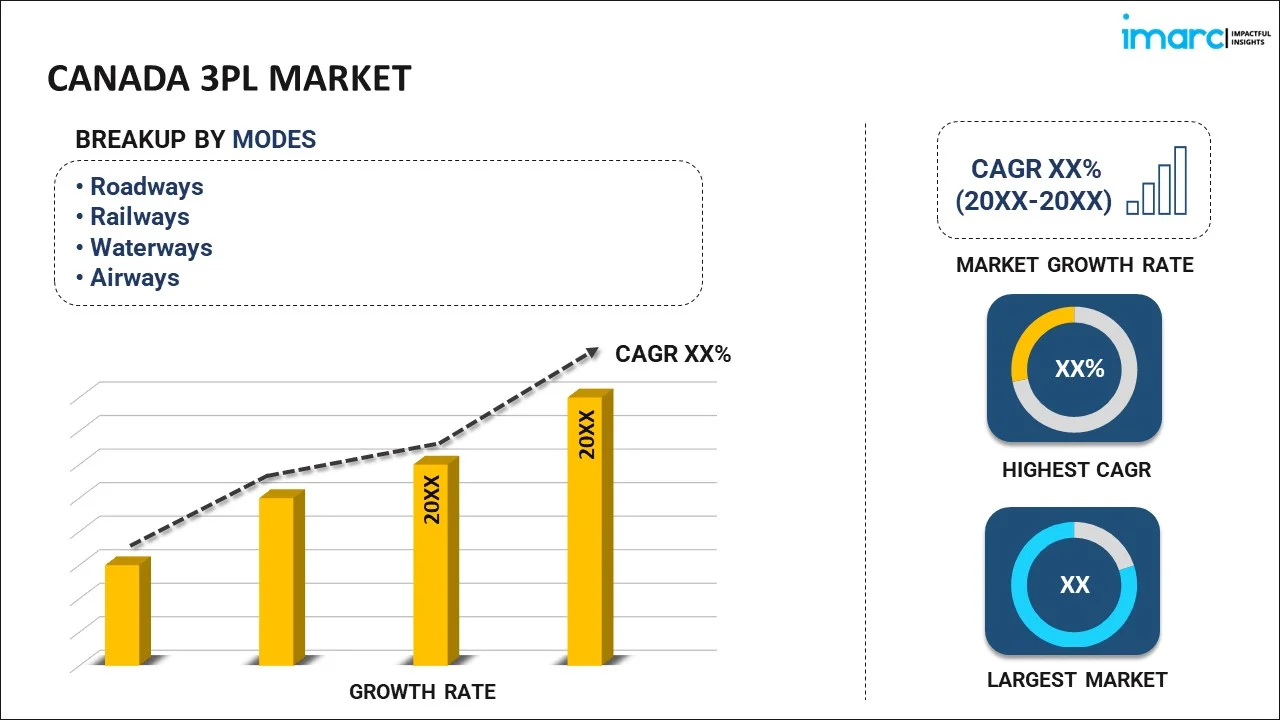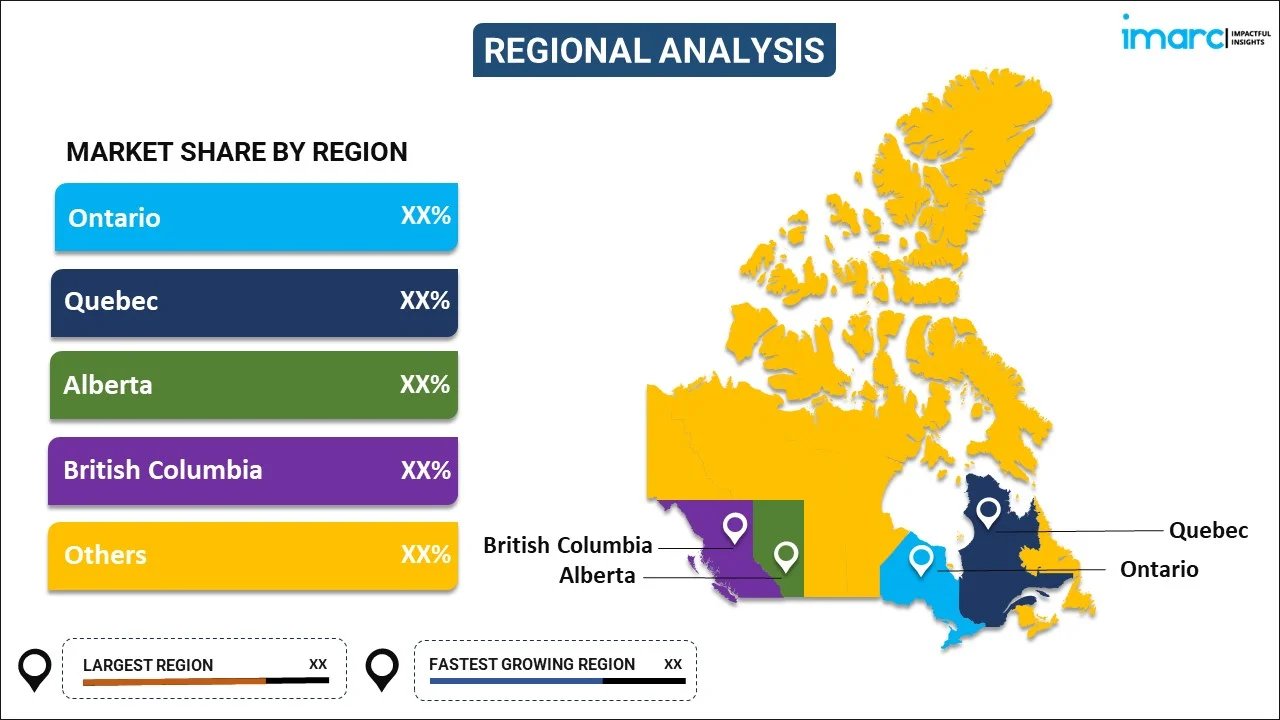
Canada 3PL Market Report by Mode (Roadways, Railways, Waterways, Airways), Services (Dedicated Contract Carriage (DCC)/Freight Forwarding, Domestic Transportation Management (DTM), International Transportation Management (ITM), Warehousing and Distribution, Value Added Logistics Services (VALs)), End Use (Automotive, Manufacturing, Chemical, Retail, Healthcare and Pharmaceuticals, Construction, and Others), and Region 2024-2032
Canada 3PL Market Overview:
The Canada 3PL market is projected to exhibit a growth rate (CAGR) of 4.60% during 2024-2032. The increasing e-commerce growth, the rising demand for efficient supply chain management, advancements in technology, rapid globalization, the growing need for cost-effective logistics solutions, and the expansion of trade agreements are some of the major factors driving the growth of the market.
|
Report Attribute
|
Key Statistics
|
|---|---|
|
Base Year
|
2023 |
|
Forecast Years
|
2024-2032
|
|
Historical Years
|
2018-2023
|
| Market Growth Rate (2024-2032) | 4.60% |
Canada 3PL Market Trends:
E-commerce Growth
The rapid expansion of e-commerce in Canada significantly boosts the demand for efficient logistics and fulfillment services. This is further prompting businesses to rely on 3PL providers to manage their supply chains and meet consumer expectations for fast and reliable deliveries. According to the International Trade Administration, in 2022, there were over 27 million eCommerce users in Canada, accounting for 75% of the Canadian population. This number is expected to grow to 77.6% in 2025. According to Statistics Canada, eCommerce retail trade sales in Canada amounted to an all-time high of US$3.82 billion in December 2020, surpassing the boost recorded in May 2020 (US$3.2 billion) due to the coronavirus pandemic lockdown measures. In March 2022, e-commerce sales amounted to approximately US$2.34 billion. It is estimated that retail eCommerce sales will total US$40.3 billion by 2025. Retailers are investing in digital platforms to reach consumers dispersed over a vast landmass while responding to competition from websites, such as Amazon Canada. Fifty-nine percent of Canadian shoppers use credit cards when shopping online and a further 20% use PayPal. Digital wallets are steadily increasing and are estimated to account for 27% of online payments by 2025.
Technological Advancements
The widespread adoption of advanced technologies like IoT, AI, and automation in logistics operations improves tracking, inventory management, and route optimization which is acting as a major growth-inducing factor. 3PL providers leveraging these technologies offer enhanced services, driving their demand in the market. For instance, in April 2024, Oracle launched updated artificial intelligence (AI) capabilities in its Oracle Fusion Cloud Supply Chain & Manufacturing platform. The software company added new AI capabilities in a bid to help companies increase efficiencies throughout their operations. The tactic has been popular among supply chain software providers, who have added AI features promising to help with a broad range of rote tasks, such as risk prediction or inventory visibility.
Canada 3PL Market News:
- In February 2024, Farrow announced that Kuehne+Nagel Group had closed on the deal to acquire Farrow. With this closing, Farrow becomes a wholly owned subsidiary of Kuehne+Nagel. The Farrow name and team remain in place, and the organization will continue to operate as a stand-alone business under its current executive leadership team and the guidance of Rick Farrow.
- In June 2024, ECU Worldwide, a wholly owned global subsidiary of Allcargo Logistics, partnered with ShipBob to offer its ocean and air freight services to the latter's receiving hubs and fulfillment centres in the US, Europe, Canada, and Australia. Under the collaboration, ECU Worldwide will become an integral part of FreightBob, an end-to-end managed freight and inventory distribution program of ShipBob, through its network across over 180 countries, more than 2,400 direct trade lanes and door-to-door deliveries.
Canada 3PL Market Segmentation:
IMARC Group provides an analysis of the key trends in each segment of the market, along with forecasts at the country level for 2024-2032. Our report has categorized the market based on mode, services, and end use.
Mode Insights:

- Roadways
- Railways
- Waterways
- Airways
The report has provided a detailed breakup and analysis of the market based on the mode. This includes roadways, railways, waterways, and airways.
Services Insights:
- Dedicated Contract Carriage (DCC)/Freight Forwarding
- Domestic Transportation Management (DTM)
- International Transportation Management (ITM)
- Warehousing and Distribution
- Value Added Logistics Services (VALs)
A detailed breakup and analysis of the market based on the services have also been provided in the report. This includes dedicated contract carriage (DCC)/freight forwarding, domestic transportation management (DTM), international transportation management (ITM), warehousing and distribution, value added logistics services (VALS).
End Use Insights:
- Automotive
- Manufacturing
- Chemical
- Retail
- Healthcare and Pharmaceuticals
- Construction
- Others
The report has provided a detailed breakup and analysis of the market based on the end use. This includes automotive, manufacturing, chemical, retail, healthcare and pharmaceuticals, construction, and others.
Regional Insights:

- Ontario
- Quebec
- Alberta
- British Columbia
- Others
The report has also provided a comprehensive analysis of all the major regional markets, which include Ontario, Quebec, Alberta, British Columbia, and others.
Competitive Landscape:
The market research report has also provided a comprehensive analysis of the competitive landscape. Competitive analysis such as market structure, key player positioning, top winning strategies, competitive dashboard, and company evaluation quadrant has been covered in the report. Also, detailed profiles of all major companies have been provided.
Canada 3PL Market Report Coverage:
| Report Features | Details |
|---|---|
| Base Year of the Analysis | 2023 |
| Historical Period | 2018-2023 |
| Forecast Period | 2024-2032 |
| Units | US$ Billion |
| Scope of the Report | Exploration of Historical Trends and Market Outlook, Industry Catalysts and Challenges, Segment-Wise Historical and Future Market Assessment:
|
| Modes Covered | Roadways, Railways, Waterways, Airways |
| Services Covered | Dedicated Contract Carriage (DCC)/Freight Forwarding, Domestic Transportation Management (DTM), International Transportation Management (ITM), Warehousing and Distribution, Value Added Logistics Services (VALs) |
| End Uses Covered | Automotive, Manufacturing, Chemical, Retail, Healthcare and Pharmaceuticals, Construction, Others |
| Regions Covered | Ontario, Quebec, Alberta, British Columbia, Others |
| Customization Scope | 10% Free Customization |
| Post-Sale Analyst Support | 10-12 Weeks |
| Delivery Format | PDF and Excel through Email (We can also provide the editable version of the report in PPT/Word format on special request) |
Key Questions Answered in This Report:
- How has the Canada 3PL market performed so far and how will it perform in the coming years?
- What has been the impact of COVID-19 on the Canada 3PL market?
- What is the breakup of the Canada 3PL market on the basis of mode?
- What is the breakup of the Canada 3PL market on the basis of services?
- What is the breakup of the Canada 3PL market on the basis of end use?
- What are the various stages in the value chain of the Canada 3PL market?
- What are the key driving factors and challenges in the Canada 3PL?
- What is the structure of the Canada 3PL market and who are the key players?
- What is the degree of competition in the Canada 3PL market?
Key Benefits for Stakeholders:
- IMARC’s industry report offers a comprehensive quantitative analysis of various market segments, historical and current market trends, market forecasts, and dynamics of the Canada 3PL market from 2018-2032.
- The research report provides the latest information on the market drivers, challenges, and opportunities in the Canada 3PL market.
- Porter's five forces analysis assist stakeholders in assessing the impact of new entrants, competitive rivalry, supplier power, buyer power, and the threat of substitution. It helps stakeholders to analyze the level of competition within the Canada 3PL industry and its attractiveness.
- Competitive landscape allows stakeholders to understand their competitive environment and provides an insight into the current positions of key players in the market.
Need more help?
- Speak to our experienced analysts for insights on the current market scenarios.
- Include additional segments and countries to customize the report as per your requirement.
- Gain an unparalleled competitive advantage in your domain by understanding how to utilize the report and positively impacting your operations and revenue.
- For further assistance, please connect with our analysts.
 Inquire Before Buying
Inquire Before Buying
 Speak to an Analyst
Speak to an Analyst
 Request Brochure
Request Brochure
 Request Customization
Request Customization




.webp)




.webp)












